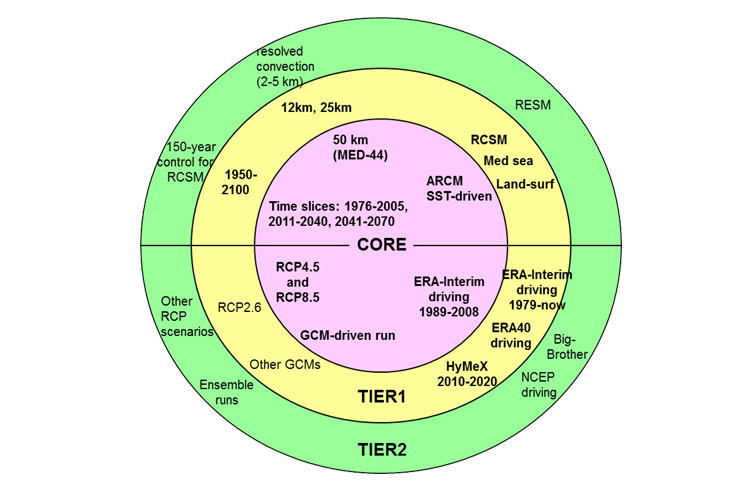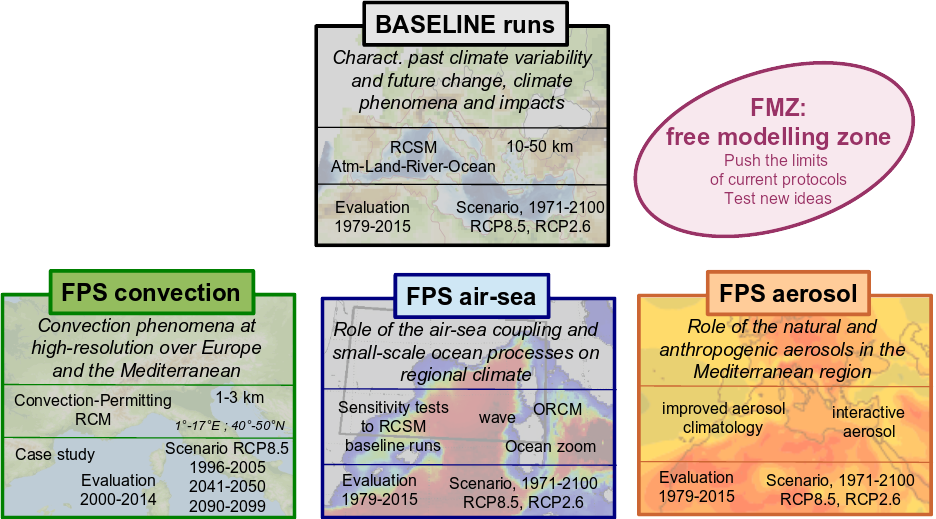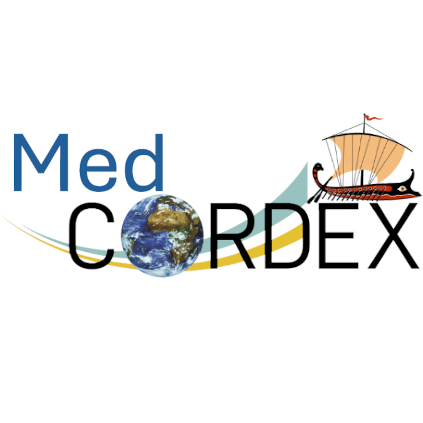Table of Contents
Phase 1
In its phase 1, Med-CORDEX simulations gather 3 kinds of runs (evaluation, historical, scenario), 4 kinds of regional models (atmosphere, land-surface, ocean, coupled RCSM) and are classified in two categories: CORE simulations and TIER1 simulations.
CORE simulations
The framework for the Med-CORDEX CORE simulations follows the CORDEX frame over the Mediterranean domain (MED-44):
- Atmosphere-Land only
- 50 km over the MED-44 CORDEX domain
- Evaluation run (ERA-Interim driven runs, 1989-2008 minimum)
- Historical runs (1981-2005 minimum, 1950-2005 advised)
- Scenario runs (RCP8.5, RCP4.5, 2011-2040 or 2041-2070 minimum, 2006-2100 advised)
The simulations are also described on the HyMeX database web site. Each form corresponds to one simulation and gives some details about the model, the reference article, the modelling group, etc. It is also possible to access the simulations archived on the MED-CORDEX database from those forms.
TIER-1 simulations
The TIER1 Med-CORDEX simulations include:
- Extension of the ERA-Interim evaluation CORDEX runs to the longest possible period and in particular to present in order to use the most recent evaluation data available and the HyMeX field campaign results. The period 1979-2013 is advised.
- Production of an ensemble of higher-resolution atmosphere RCM: target resolution is 0.11°, about 12 km (MED-11) but intermediate resolutions are possible.
- Production of an ensemble of simulations with coupled Regional Climate System Models (RCSM), i.e. with fully interactive Atmosphere-Land surface-River-Ocean components, covering the whole Mediterranean basin at high resolution.
- Production of stand-alone simulations for all the components of the RCSM

Participating teams
Med-CORDEX gathered 22 different modelling groups from 9 different countries in Europe, Middle-East and North-Africa:
| Country |
|---|
 France France |
 Germany Germany |
 Greece Greece |
 Hungary Hungary |
 Italy Italy |
 Serbia Serbia |
 Spain Spain |
 Tunisia Tunisia |
 Turkey Turkey |
The registered modelling groups were:
Participating models
- 17 different Atmosphere-RCM (resolution between 10 and 50km)
- 8 different Ocean regional models
- 4 different Land-Surface regional models
- 14 Fully coupled Regional Climate System Models (at least ocean-atmosphere-land)
- 8 GCMs used for the scenario runs
List of simulations
Note that the following pdf files contain links towards the description of each run (metadata). Clicking such links you access the run information.
- Atmosphere Regional Climate Models
- Land-River Regional Climate Models
- Ocean Regional Climate Models
- Fully-coupled Regional Climate System Models
- GCM x RCM matrix
Phase 2
In its phase 2 (from 2016 onwards), the overarching goals of the Med-CORDEX initiative (rephrased from Ruti et al. 2016) are to:
A. Understand the past variability of the Mediterranean regional climate system and characterize its possible future evolution.
B. Investigate, understand and improve the description of regional climate phenomena with emphasis on phenomena of importance for climatic impacts.
C. Contribute to improve the characterization of the impacts of the Mediterranean climate variability and climate change.
To full-filled these goals, the phase 2 of Med-CORDEX is based on five modelling pillars:
- The Baseline runs based on a large ensemble of fully-coupled regional climate system models inherited from Med-CORDEX phase 1.
- The CORDEX FPS-convection based on convection-permitting regional climate models
- The CORDEX FPS-aerosol based on an improved representation of aerosols in the regional climate models
- The CORDEX FPS-airsea based on an improved representation of small-scale oceanic processes and air-sea coupling in the region climate system models
- The Free Modelling Zone (FMZ) targeting to study the limitations of the current Med-CORDEX modelling protocols and to test new modelling ideas
FPS: Flagship Pilot Study, the 3 Med-CORDEX related FPS have been endorsed officially by CORDEX in May 2016

In its phase 2 as in its phase 2, Med-CORDEX is based on the following motivations and basic principles:
- Mediterranean area is considered as a perfect test case for high-resolution and coupled regional climate modelling and a well-identified future climate change hotspot
- Following the end of the CIRCE EU project, Med-CORDEX started in 2009 as the HyMeX regional climate modelling team before becoming an official CORDEX domain
- Med-CORDEX is an open club of Mediterranean climate model developers and users ; self-organised and based on voluntary efforts.
- Med-CORDEX targets to develop reference modelling frameworks for the study the Mediterranean climate and to provide coordinated regional climate simulations for the various components of the Mediterranean climate system
- Med-CORDEX is mainly science-driven
- The major communication tools are the mailing list (medcordex@hymex.org), the web site (www.medcordex.eu) and regular workshops
- Med-CORDEX is leaded by an international steering committee (medcordex-sc@hymex.org): S.Somot (CNRM) ; G.Sannino (ENEA) ; E.Coppola (ICTP) ; G.Jordà (IMEDEA) ; B.Ahrens (GUF) ; F. Solmon (LA)
- Med-CORDEX contributes to the objectives of the following initiatives and projects: CORDEX, MISTRALS (HyMeX, ChArMEx, ImpactCC), Med-CLIVAR, C3S, HORIZON-2020 and MedECC


